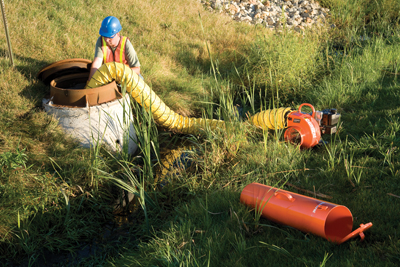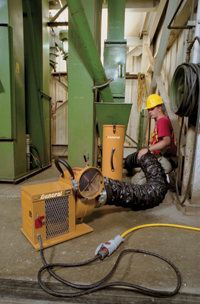
Blowers: Clearing the air
By By Dennis Von Ruden President General Equipment Company
ProductsLet’s face it, portable ventilation blowers have a single purpose – to move air. So, even though they can be critically important to jobsite safety, they are probably not the most glamorous equipment in your rental centre’s inventory.
Let’s face it, portable ventilation blowers have a single purpose – to move air. So, even though they can be critically important to jobsite safety, they are probably not the most glamorous equipment in your rental centre’s inventory. But, while the concept of confined space ventilation may seem extremely simple, the typical application for a portable blower can require a considerable amount of thought and experience – typically more than that of a generator or pump rental. A large percentage of dealers fail to recognize this aspect of the ventilation equation, however, and unknowingly place their customers at risk.
 |
| Blowers may not be glamorous, but proper air movement can be key to the success of your customers’ projects.
|
For most customers, rental centres are more than a place to find proper equipment – they’re a source of knowledge, information and practical experience on how to get their job done right. Unfortunately, it’s far too common for dealers to have less than desirable expertise when it comes to portable ventilation blowers.
The presumption is that all ventilation blowers move air, so they are basically the same. At least they all look similar, right? Well, not really. The quiet truth is that there are a number of different designs and configurations of blowers on the market, some with specific features intended for specialized applications. There is no one-size-fits-all solution to confined space ventilation, especially when it comes to allowing the customer to carry it out safely while minimizing liability exposure. Therefore, the proactive rental centre operator needs to become better educated on the fundamentals of confined space ventilation.
Decisions, decisions
Rental dealers inventory equipment based upon customer demand, both actual and perceived. When customers started showing up 15 years ago asking about ventilation blowers, the natural response was to add inventory to meet this new demand. Since the concept was new and experience was non-existent, blowers were often perceived as “just a commodity.” Many rental centre operators used no rhyme or reason when adding them to their inventory. In fact, many purchased a blower just to have one on hand, and the only thing they really knew about the unit was where to find it on
the shelf.
Often, the purchase was based on price alone, or sometimes they chose to buy from their favourite sales representative (who may or may not have been experienced and knowledgeable about the product). That was then, but today is much different. The confined space ventilation market has matured and purchasing decisions have become more sophisticated. Or have they?
Most stores already carry a number of ventilation blowers in inventory. But does that inventory meet customer needs? Do rental operators know what their customers’ needs are? Do the customers even know? These questions require a serious understanding of confined space ventilation. Of course, it’s probably not the most important thing on your mind. After all, more than 99 per cent of the time an incorrect ventilation procedure is used, nobody gets hurt.
 |
|
| You can add value by knowing the confined space ventilation regulations, and by educating your staff on the differences between hazardous and non-hazardous jobsites. |
So, what’s the worst that can happen by not stocking or renting the right blower for the specific job application? Efficiency, profitability and satisfaction (not to mention return on investment) can all suffer when customers don’t get the proper knowledge, training or equipment. But if that isn’t enough to persuade you, consider that approximately 100 people still die unnecessarily each year due to ignorance of confined space ventilation issues.
The majority of these tragedies can be prevented by simple education and the use of proper equipment. So, what needs to be done when renting confined space ventilation blowers? The first step is to have a working knowledge of confined space ventilation fundamentals and procedures to help educate customers. If your personnel are not confident in their knowledge level, they should ask the blower manufacturer for help or contact their local safety providers. Even the Occupational Safety and Health Administration (OSHA) can be of assistance.
The second step is to use this working knowledge to clearly understand your customer’s needs – even when he might not know his own needs. Not every customer has a clear idea of what he wants to do or how it will get accomplished, so rental centre personnel must ask the tough, but necessary, questions. These questions may help prevent an injury or save a life. Isn’t that alone worth the extra effort? Finally, the third step is the proper assessment to supply the right solutions to meet customer needs.
Where do you work?
When a customer is looking to rent a portable ventilation blower, the first and absolutely most important questions to ask are about the location at which it will be used. Is it hazardous or non-hazardous? Does anyone know? Does the customer know the difference? Hazardous locations are clearly defined by the Canadian Electric Code (CEC), and these sites contain flammable gases or combustible materials in the air. Gasoline tanks and utility gas plants are somewhat obvious hazardous locations, but you may not realize that grain elevators, chemical plants and sawmills also pose a threat. It’s important to discuss the hazardous location concern because if the wrong equipment is used at these sites, deadly explosions can result.
What’s so special about hazardous location-type blowers? To help prevent accidents, manufacturers build hazardous location ventilation blowers with aluminum or special plastic housings, which will not spark when contacted. They also incorporate an “explosion-proof” electric motor. While the name seems to suggest the blower is not capable of setting off an explosion in a hazardous atmosphere, that isn’t the case. An explosion-proof motor can still allow an internal explosion to occur. However, if an internal explosion does occur, the structural integrity of the motor will hold up, and the unit won’t burst into shrapnel – a very important fact for rental centre employees to know.
Furthermore, these blowers feature spark-proof housings and special wiring. They also use black, statically conductive ducts, rather than the standard yellow or orange ones, to reduce the chance of a spark from static electricity discharge. Although hazardous location blowers aren’t common within the rental industry, the centres that serve niche markets, such as ship repair or oil storage, must be prepared for customers with these needs.
The powers that be
Blowers are available with several different power sources to best cover the variations of jobsites – AC electric motors, DC electric motors, gasoline engines and diesel engines. However, AC- and gasoline-powered units make up the majority of rentals, as DC- and diesel-powered blowers mainly serve niche markets, such as utility work.
On jobsites with a readily available 115 VAC electric power source, blowers with AC electric motors often make the most sense. Because of carbon monoxide concerns, units powered by gasoline engines are typically reserved for outside applications when no electric power source is available.
Doing the math
The next important factor in selecting a portable ventilation blower is the size of the confined space. The volume of the workspace, combined with air-recirculation regulations, will determine the size and number of blowers needed. Since regulations vary, rental centre operators should check their provincial laws to see how many times the air in a confined space must be circulated per hour.
Take, for example, a confined workspace with a volume of 110 cubic metres. This volume must then be multiplied by the hourly recirculation rate. If the law requires a minimum of six times per hour, the location needs 660 cubic metres of air to be moved each hour. To convert hours into minutes, divide 660 by 60, which equals 11 cubic metres per minute. Now, convert to English units to come up with 388 cubic feet per minute (CFM). Therefore, to meet regulations, a blower with at least a 388 CFM rating must be used, or a combination of blowers can be set up to equal 388 CFM.
Intelligent design
Blower design plays an integral role in reaching the required CFM. Although these machines appear to be very simple, their axial and radial configurations closely mirror the technology of jet engines.
Up to 2,000 CFM, radial configur-ations offer unsurpassed durability and performance for the physical size of the product. Additionally, if an electrical outlet is not available, radial type blowers are the only available choice, as the axial configuration does not easily accommodate mounting an engine. However, with the enhanced thrust that axial flow configurations provide, they are an obvious answer for moving large volumes of air – generally above 2,000 CFM.
Air flow also depends heavily on the duct. Due to friction, ducts that are longer than 7.6 metres exponentially decrease the air flow that can be delivered to a confined space, and bends in the duct – especially those with an angle of more than 90 degrees – also reduce the effectiveness of a blower.
Little things matter
Though we’ve discussed some of the most important considerations to take into account, the construction of a ventilation blower might also help determine the suitability for a specific job. Plastic units obviously weigh less than metal alternatives, but can have greater difficulty withstanding the abuse found in the equipment rental industry. Plastic also cracks more easily when operated at low ambient temperatures. On the other hand, metal units have a long and demonstrated history of withstanding abuse (a big plus in the rental industry), but if the paint finish is not properly maintained, rusting and an overall degradation of appearance will occur.
While selecting a blower to rent to your customers isn’t rocket science, it does require some careful consideration of the jobsite conditions and applicable safety regulations. Don’t take the ventilation process – or your next blower purchase – for granted. Add some real value by getting to know the confined space ventilation regulations and how they can directly affect both you and your customers. Educate personnel on the differences between a hazardous and non-hazardous jobsite. Getting them comfortable with the entire ventilation process will increase their confidence to ask the tough questions – questions that will ultimately provide the most productive and safest solutions for your customers.
Print this page
Leave a Reply